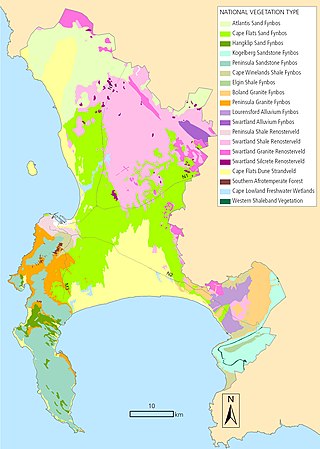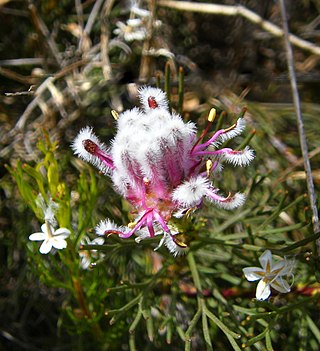
Serruria, or spiderhead is a genus of flowering plants in the family Proteaceae, endemic to South Africa.

The Biodiversity of Cape Town is the variety and variability of life within the geographical extent of the City of Cape Town metropolitan municipality, excluding the Prince Edward Islands. The terrestrial vegetation is particularly diverse and much of it is endemic to the city and its vicinity. Terrestrial and freshwater animal life is heavily impacted by urban development and habitat degradation. Marine life of the waters immediately adjacent to the city along the Cape Peninsula and in False Bay is also diverse, and while also impacted by human activity, the habitats are relatively intact.

Cape Flats Sand Fynbos (CFSF), previously known as Sand Plain Fynbos, is a critically endangered vegetation type that occurs only within the city of Cape Town. Less than 1% of this unique lowland fynbos vegetation is conserved.

Swartland Shale Renosterveld is a critically endangered vegetation type of the Western Cape, South Africa.

Durbanville Nature Reserve is a 6-hectare (15-acre) piece of protected land, located next to the Hollywoodbets Durbanville Racecourse in the Western Cape, South Africa.

Tokai Park, previously known as "Tokai Forest", is a small wing, about 600 ha, of the greater Table Mountain National Park in Cape Town, South Africa. Tokai Park is made up of two sections: upper and lower Tokai Park. Lower Tokai Park is flat, and characterized by the threatened Cape Flats Sand Fynbos. Upper Tokai Park is on the slopes of Constantiaberg Mountain, and consists of conservation area as well as the Tokai Arboretum. Upper Tokai Park is characterized by Peninsula Granite Fynbos, Peninsula Sandstone Fynbos and Afromontane Forest and noted for its diversity.

Serruria elongata or long-stalk spiderhead is a plant belonging to the protea family. It is an erect, hairless shrublet of 1–1½ m (3½–5 ft) high with densely set, alternate, finely divided leaves lower down the plant, with needle-like segments. On top of an up to 30 cm (12 in) long inflorescence stalk are several, loosely arranged heads of pin-like, densely silvery-haired flower buds, each of which opens with four curled, magenta pink corolla lobes. The species is endemic to the southern Western Cape province of South Africa. It flowers during the southern hemisphere winter and early spring, between June and September.

Serruria fasciflora or common pin spiderhead is a species of flowering plant in the family Proteaceae. It is a sprawling to upright shrublet of 40 cm to 1 m high and about 1⁄2 m wide. It has finely divided, upward curving leaves with thread-thin segments and clusters of sweetly scented heads, each consisting of five to seven silvery pink flowers, that may be found year-round, but mostly from May to December. It is a rather widespread and common species, that is restricted to the south of the Western Cape province of South Africa.

Serruria aitonii, the marshmallow spiderhead, is a flower-bearing shrub that belongs to the genus Serruria and forms part of the fynbos. The plant is native to the Western Cape and occurs from the Cederberg and Sandveld to the Groot-Winterhoek Mountains and Piketberg. The shrub is round and grows 1.0 m tall and flowers from July to November.

Serruria furcellata, the Kraaifontein spiderhead, is a flower-bearing shrub that belongs to the genus Serruria and forms part of the fynbos. The plant is native to the Western Cape, it has always been found at Brackenfell, Kraaifontein and Kuils River.

Serruria rosea, the rose spiderhead, is a flower-bearing shrub that belongs to the genus Serruria and forms part of the fynbos. The plant is native to the Western Cape, South Africa.

Serruria decipiens, the Sandveld spiderhead, is a flower-bearing shrub that belongs to the genus Serruria. It forms part of the fynbos biome. The plant is native to the Western Cape, where it only occurs on the Sandveld, Hopefield, the Cape Flats, Piketberg, and Olifants River Mountains. The shrub is round and grows 1.0 m tall and bears flowers from July to October.

Serruria fucifolia, the northern spiderhead, is a flower-bearing shrub that belongs to the genus Serruria and forms part of the fynbos. The plant is native to the Western Cape, South Africa.

Serruria brownii, the bottlebrush spiderhead, is a flower-bearing shrub that belongs to the family Proteaceae and forms part of the fynbos. The plant is native to the Western Cape, South Africa.
Serruria cyanoides, the Wynberg spiderhead, is a flower-bearing shrub that belongs to the genus Serruria and forms part of the fynbos.

Serruria glomerata, the cluster spiderhead, is a flower-bearing shrub that belongs to the genus Serruria and forms part of the fynbos. The plant is native to the Western Cape, it occurs on the Cape Flats and Cape Peninsula. The shrub is erect and grows only 40 cm tall and bears flowers from August to October.

Serruria villosa, the golden spiderhead, is a flower-bearing shrub that belongs to the genus Serruria and forms part of the fynbos. The plant is native to the Western Cape, where it occurs only on the Cape Peninsula and just south of Constantia. The shrub is erect and grows only 50 cm tall and bears flowers from April to July.

Serruria stellata, the star spiderhead, is a flower-bearing shrub that belongs to the genus Serruria and forms part of the fynbos. The plant is native to the Western Cape, South Africa.
Serruria balanocephala, the acorn spiderhead, is a flower-bearing shrub that belongs to the genus Serruria and forms part of the fynbos. The plant is native to the Western Cape and occurs on the Langeberg between Montagu and Swellendam. The shrub grows upright and grows 1.0 m long and flowers from late August to December.
Serruria confragosa, the wavy spiderhead, is a flower-bearing shrub that belongs to the genus Serruria and forms part of the fynbos. The plant is native to the Western Cape and occurs in the Koue Bokkeveld Mountains and Great Winterhoek Mountains. The shrub grows upright with few branches and grows 1.0 m tall, and flowers from September to November.





















